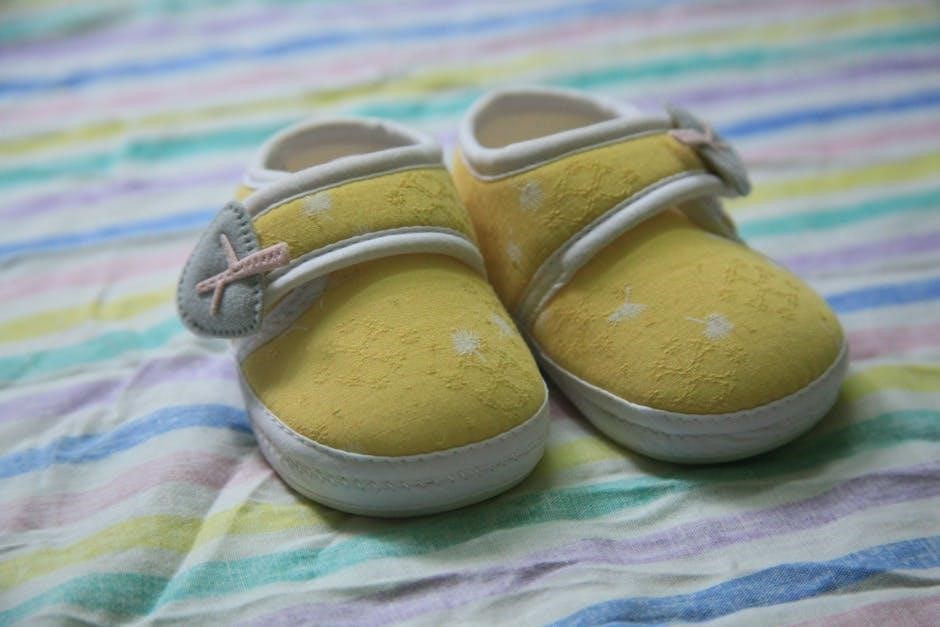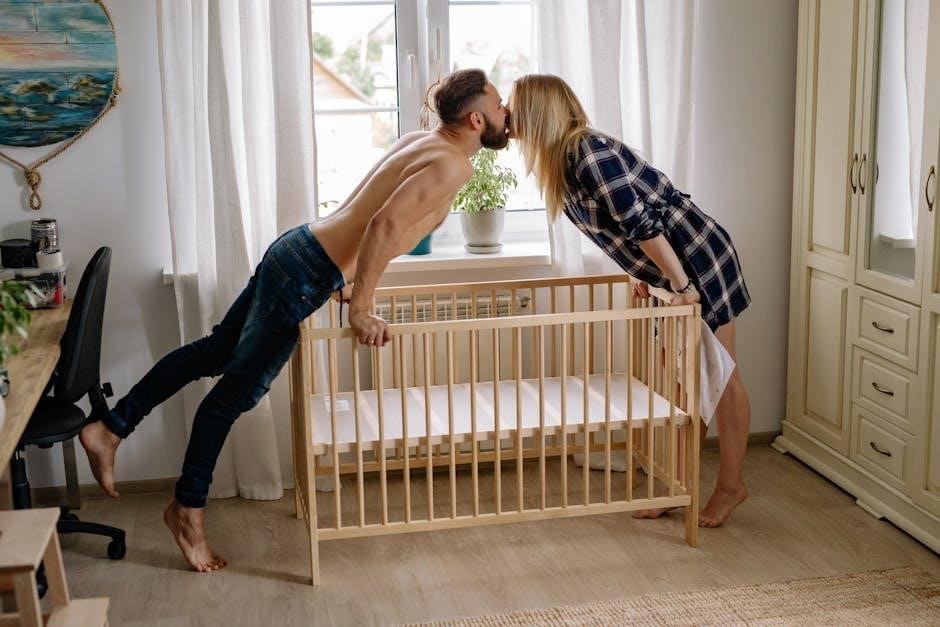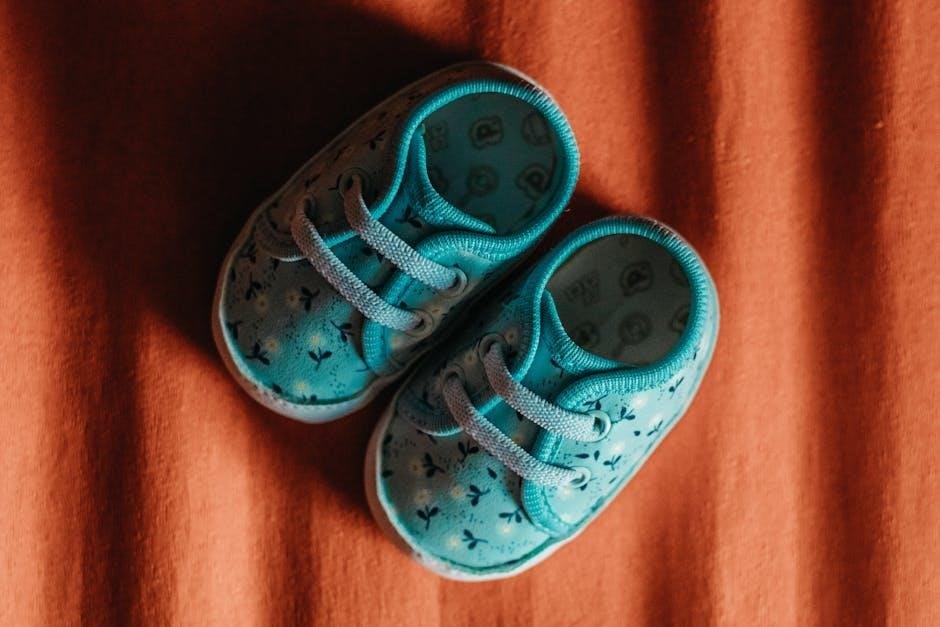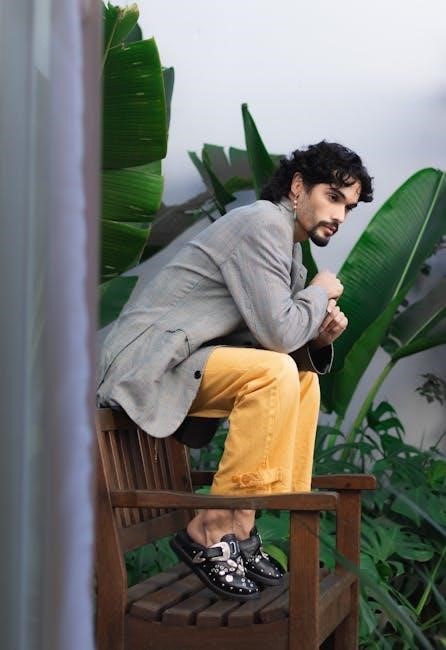Crib shoes are essential for your baby’s foot health, providing protection and support. Made from soft, breathable materials, they ensure comfort and proper development.
Understanding the Importance of Proper Sizing
Proper sizing in crib shoes is crucial for your baby’s foot health and comfort. Ill-fitting shoes can lead to discomfort, foot pain, or even developmental issues. A well-fitted crib shoe allows toes to wiggle freely, preventing restrictions that could hinder growth. Proper sizing ensures your baby’s feet have enough room to grow while providing the necessary support for standing and walking. It’s essential to prioritize accurate measurements to avoid potential long-term foot problems and ensure your baby’s feet stay healthy and happy.

How to Measure Your Baby’s Foot
To measure your baby’s foot, trace the outline on paper or use a ruler to record the length and width for accurate crib shoe sizing.
Using a Ruler to Measure Foot Length
Place your baby’s foot on a flat surface and gently align the heel with the edge of a ruler. Measure from the back of the heel to the tip of the longest toe; Ensure the foot is relaxed and not curled. Record the measurement in centimeters or inches for accuracy. This method provides a clear baseline for determining crib shoe size, ensuring a comfortable and proper fit for your baby’s growing feet.
How to Use a Brannock Device for Accurate Measurement
Place the Brannock device on a flat surface and slide your baby’s foot into it until the heel touches the back. Adjust the sliding bar to align with the tip of the longest toe. Read the size from the scale, noting both length and width. This tool ensures precise measurements, helping you find the perfect crib shoe size for your baby’s comfort and proper foot development. Regular use can track growth and guide future purchases accurately.
Crib Shoe Size Chart
A crib shoe size chart helps determine the perfect fit by age, typically ranging from size 0 (newborn) to 6 (12-18 months). Use measurements for accuracy.
Age-Related Size Guidelines
Crib shoe sizes typically correlate with a baby’s age, ranging from newborn (size 0) to 12-18 months (size 6). Newborns (0-3 months) usually fit size 0, while infants (3-6 months) wear size 1. Babies 6-9 months old often need size 2, and 9-12 months typically fit size 3. For 12-18 months, sizes 4-6 are appropriate. Keep in mind that foot growth varies, so regular measurements are crucial. Always check the size chart for specific brands, as sizing may differ slightly. Proper fit ensures comfort and healthy foot development for your baby.
How to Choose the Right Size Based on Foot Shape
Foot shape plays a significant role in selecting crib shoes. Measure the length and width of your baby’s foot to determine the best fit. Use a ruler or Brannock device for accuracy. Some babies have narrower or wider feet, so check if the brand offers specific fits. For example, brands like Robeez and Start-Rite provide size charts for different foot shapes. While age can guide size selection, foot shape and growth patterns are more reliable indicators. Ensure the shoes accommodate the foot’s natural shape to promote healthy development and comfort.

Materials and Features to Consider
Crib shoes should be made from soft, breathable materials to ensure comfort and proper foot development. Look for features like adjustable straps and cushioned insoles.
Why Soft, Breathable Materials Are Essential
Soft, breathable materials are crucial for crib shoes as they prevent moisture buildup and reduce odor. They allow the skin to breathe, preventing irritation and promoting healthy foot development. Natural fibers like cotton and bamboo are ideal, as they wick away sweat and keep feet dry. Avoid stiff or synthetic materials that can cause discomfort. Breathable shoes help regulate temperature, ensuring tiny feet stay cool in summer and warm in winter. This is especially important for babies, as their skin is delicate and sensitive to environmental changes.
Key Features to Look for in Crib Shoes
When selecting crib shoes, prioritize soft, flexible soles for natural foot movement and non-slip traction for stability. Adjustable closures ensure a secure fit, while lightweight designs promote comfort. Opt for seamless construction to avoid irritation and choose shoes with room for growth. Durable materials withstand wear, and easy-on, easy-off designs simplify use. Breathable fabrics keep feet cool and dry, essential for sensitive skin. These features collectively ensure comfort, support, and safety for your baby’s developing feet.

When to Buy Crib Shoes
Buy crib shoes when your baby transitions from pre-walking to walking, ensuring proper fit for growth and support. Consider seasonal needs for comfort and protection.
Signs Your Baby is Ready for Crib Shoes
Watch for cues like your baby pulling themselves up or showing interest in walking; If they outgrow pre-walking shoes, it’s time for crib shoes. Proper fit is key.
Seasonal Considerations for Crib Shoe Purchases
Choose crib shoes based on the season to ensure comfort and practicality. Opt for lightweight, breathable materials in summer and warmer, insulated options in winter. Consider waterproof styles for rainy or snowy conditions. Summer sandals and winter boots are popular choices. Additionally, many brands offer seasonal collections, making it easier to find styles suited to specific weather. Keep in mind that sales often align with seasonal needs, so plan purchases accordingly to ensure your baby’s feet stay comfortable year-round.

Common Mistakes to Avoid
- Relying solely on age for sizing instead of measuring the foot.
- Not checking for proper fit, leading to discomfort or restricted growth.
- Ignoring the shape of the foot when choosing a style.
- Prioritizing aesthetics over comfort and functionality.
The Dangers of Ill-Fitting Crib Shoes
Ill-fitting crib shoes can cause discomfort, blisters, and even long-term foot issues. Tight shoes may restrict toe movement, potentially leading to deformities like hammertoes or bunions. Loose shoes can cause friction and instability, increasing the risk of tripping. Poorly fitting shoes may also lead to improper gait development. Additionally, materials that lack breathability can cause skin irritation or fungal infections. Ensuring a proper fit is crucial for your baby’s foot health and comfort. Always measure carefully and choose shoes made from soft, breathable materials.
Why You Shouldn’t Rely Solely on Age for Sizing
While age can provide a general guideline, it’s not a reliable sole indicator for crib shoe sizing. Babies grow at different rates, and foot sizes can vary significantly. Some may have longer or wider feet, while others might develop faster due to genetic factors. Relying only on age risks choosing shoes that are too tight or too loose, leading to discomfort or poor support. Always measure your baby’s foot and consult size charts for accurate fitting, as individual growth patterns can differ from average expectations.
Top Brands for Crib Shoes
Top brands like Robeez and Start-Rite are known for accurate sizing and high-quality materials. They prioritize proper fit and foot health, essential for your baby’s comfort and development.
Brands Known for Accurate Sizing
Brands like Robeez and Start-Rite are renowned for their precise sizing charts and measuring tools. They offer size calculators to ensure the perfect fit, prioritizing foot health and comfort. These brands provide detailed guides, helping parents choose the right size based on their baby’s foot measurements. With a focus on accuracy, they minimize the risk of ill-fitting shoes, ensuring optimal support and comfort for growing feet. Their commitment to proper sizing makes them trusted choices for parents seeking the best for their babies.
How to Check Size Charts for Different Brands
To ensure the best fit, always consult the size chart specific to each brand. Compare your baby’s foot measurements to the chart, noting any variations between brands. Some brands, like Robeez, offer size calculators, while others, like Start-Rite, provide detailed guides. Double-check the width and length measurements, as sizing can differ slightly. Pay attention to features like adjustable straps, which can enhance fit accuracy. By carefully reviewing each brand’s sizing guide, you can make informed decisions and ensure your baby’s comfort and proper foot development.
Tips for Parents
Always check size charts for accurate fits and consider your baby’s activity level. Opt for breathable materials and inspect shoes regularly to ensure proper fit and comfort.
How to Care for Crib Shoes
Regularly clean crib shoes with a soft cloth and mild detergent. Avoid harsh chemicals to maintain breathability. Allow shoes to air-dry away from direct sunlight to prevent damage. Store them in a cool, dry place to retain shape. Check for signs of wear and tear, and replace them if needed. Ensuring proper care extends the life of crib shoes and keeps your baby’s feet comfortable and healthy.
- Wash gently to preserve materials.
- Avoid machine drying to prevent shrinkage.
- Inspect shoes regularly for fit and condition.
When to Replace Crib Shoes
Replace crib shoes when they show signs of wear, such as holes or separated seams. If the soles are worn thin or the shoes no longer fit comfortably, it’s time for a new pair. Check regularly for proper fit, as babies’ feet grow quickly. If the shoes are too tight or the toes are cramped, replace them immediately. Additionally, consider seasonal changes to ensure the shoes remain appropriate for the weather.
- Look for visible wear or damage.
- Ensure the fit remains comfortable and supportive.
- Update sizes as your baby grows.
Choosing the right crib shoes ensures your baby’s comfort and healthy foot development. Always prioritize proper sizing, soft materials, and regular checks for growth. Happy shopping! 👣
Proper sizing is crucial for comfort and healthy foot development. Measure your baby’s feet accurately using a ruler or Brannock device. Opt for soft, breathable materials to prevent discomfort. Consider features like adjustable straps and non-slip soles for stability. Avoid ill-fitting shoes, as they can cause discomfort or developmental issues. Refer to size charts for accurate fitting, and replace shoes as your baby grows. Regularly check for wear and tear to ensure proper support. Prioritize quality and comfort for your baby’s tiny feet.
